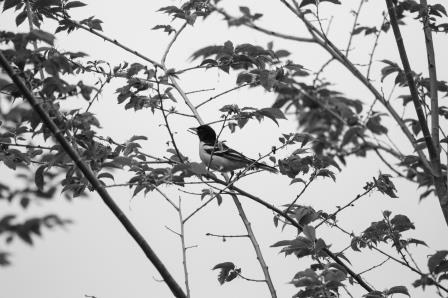Posted: July 13, 2020
As spring transitions to summer, the forests are bursting with renewed growth. We are enjoying hearing and seeing the variety of birds.

Despite the decline being seen in Pennsylvania's bird population, many landowners are reporting enjoying seeing many colorful birds this spring, like this Baltimore Oriole. Photo by Laura Kirt
We are relieved to welcome back the Whip-poor-wills and Wood Thrushes with their enchanting calls, always afraid that the spring will come when we do not hear them. The robins are boisterous, the phoebes have gone quiet while they nest in the eaves. Orioles, tanagers, Indigo Buntings and redstarts are flashing their bright colors in the trees and by the stream. Warblers are everywhere but most are too shy to allow us to identify them. Hummingbirds are quite active and abundant. Despite the decline in songbird numbers, we are seeing a lot of birds. There are certainly fewer chickadees, and the Whip-poor-wills and Wood Thrushes are well below the numbers we had in the past. The numbers are indeed declining, and so we do our best to create healthy habitat for those who arrive here. We continue bird feeding all year long. My wife, Olivia, a retired Certified Nurse Practitioner/Nurse Midwife, explains our philosophy on feeding all year as: Winter - they need the help to survive the harsh conditions. Spring - Prenatal care for the moms. Summer - feed for the fledglings and their hard-working parents. Fall - feed for the migrating and fat storage for those wintering over. I bow to her professional opinion and fill the feeders.
We are working to diversify the age class of our forest, creating openings where new younger forest can entice wildlife that needs that habitat. Our recent Golden-winged Warbler cut will certainly benefit more than that particular species. A crop tree release done 12 years ago was a failure, as an early snowfall bent most of the remaining trees down and snapped several off. They no longer had the support of their neighbors. What we viewed then as a disaster has instead turned into a young pole stage area in the forest. With thick growth and cover, it has become a wildlife oasis.
With PA's Deer Management Assistance Program (DMAP) and recruiting "alpha hunters" (those who are ardent and successful annually), we are beginning to see a resurgence of the understory. We have a way to go, but it is encouraging to see what a healthy deer harvest does to the forest. Today we found a large grouping of lady slipper orchids. We only see these when the deer numbers are beginning to balance with the habitat. This coming hunting season hunters can have up to four DMAP tags. I applied for enough to get four to each of our alpha hunters and look forward to having deer as an interesting sight in the woods rather than the pest they currently are. Thanks to Penn State Extension Educator Dave Jackson and the PFA/Tree Farm Deer Management Task Force for their work in advocating for forest landowners with the PA Game Commission. Several new initiatives that help address the deer glut in many areas have come about due in part to their work. They continue to advocate for more help.
We have also established eight small vernal pools, five of which are currently teeming with tadpoles. There is great truth in, "If you build it, they will come." Several of these pools are simply ruts left by the logger during a recent harvest. The ruts were far enough off the woods road that we could enhance them and divert water flow into them without affecting the road itself. A ten-foot-long skidder tire wide rut makes a great vernal pool. A change in hydrology from the stream has water coming up in an open area in the creek bottom. A quick scoop with the tractor bucket in two places created two more adjoining pools that are also home to tadpoles and an assortment of frogs, toads, and one yearling snapping turtle. He is in another flooded rut and seems to have decimated the tadpoles there.
This is but a part of what is happening in our forest. It is occurring across the state. The key is getting out there and making it better for all those critters. There are many places to get suggestions, technical help, guidance, and direction. The PA Forestry Association is here to point you in the direction of the help you might need. Penn State Forestry and Wildlife Extension, the Center for Private Forests, PA DCNR Service Foresters, PA Tree Farm, PA Sustainable Forestry Initiative, PA Parks and Forest Foundation, NRCS, Forestry for the Bay, PA Forest Stewards, and many others are out there with information and expertise to help you make good decisions in your woods. No matter what your goals are, these people are ready and waiting to help. Give a call. If they are not the resource you need, they can guide you to the right person or organization.
Finally, there are many webinars coming out due to the recent and current restrictions on in-person meetings. Penn State Extension has been particularly busy holding informational webinars. PFA tries to get the word out on all that come our way. Keep looking for the notices and take advantage of this great opportunity to spend an hour or so learning something new.
For more information about the PFA, visit the website at www.paforestry.org or call 800-835-0865.
James C. Finley Center for Private Forests
Address
416 Forest Resources BuildingUniversity Park, PA 16802
- Email PrivateForests@psu.edu
- Office 814-863-0401
- Fax 814-865-6275
James C. Finley Center for Private Forests
Address
416 Forest Resources BuildingUniversity Park, PA 16802
- Email PrivateForests@psu.edu
- Office 814-863-0401
- Fax 814-865-6275

